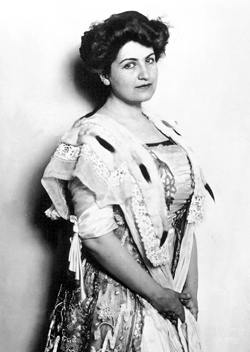
Alma Mahler - the fateful woman of artists in the first half of the 20th century
 |
Alma was attractive, educated, and remarkably musically and artistically talented, having composed a number of valued songs. According to historians, she also mastered the art of controlling men and being loved by them. Six years before her death, she published extensive memoirs, My Life, which she significantly altered and edited. Her fate attracted a number of other artists even after her death. Several films have been made about her life, several books have been written, and in the 1990s, a play titled Alma was created, which was also performed in the Czech Republic.
Alma Schindler was born into an artistic family; her father, Emil Jakob, was a respected landscape painter, and her mother, Anna, was a singer and actress. Even in her teenage years, Alma began to attract particularly older men, such as a family friend, director of the Burgtheater Max Burckhard, the already famous painter Gustav Klimt, and composer Alexander von Zemlinsky.
However, in November 1901, she met Mahler, who was then the director of the Vienna Opera. This native of a Jewish family from Kaliště near Humpolec, who had previously converted to Catholicism, was 19 years older and shorter than Alma. When Mahler was courting her, among other things, he wrote to her: "You have a single task: to make me happy." And Alma decided to marry him: "With his spirit, with my body." They were married in March 1902 and had two children together, although one daughter died when she was only five years old.
A certain estrangement then occurred between the couple, and Alma met Walter Gropius in the spa town of Tobelbad. The future star of architecture and founder of the Bauhaus, who was four years her junior, became her lover. Mahler suffered from this until his death in May 1911. Alma received a widow's pension, no longer pursued her artistic ambitions, and took care of Mahler's legacy.
After a tumultuous relationship with painter Oskar Kokoschka, who was of Jewish descent and created one of his best works, The Wind Bride, Alma married her former lover Gropius in 1915. In 1916, she gave birth to a daughter, Manon, but Alma was not faithful to Gropius either: she was captivated by another artist, the Prague-born, German-Jewish poet and prose writer Franz Werfel, who was 11 years younger. Alma was pregnant for the seventh time; in 1918, she gave premature birth to a son, Martin, whose father was probably Werfel, and who soon died.
After divorcing Gropius in 1920, she became Werfel's wife only in 1929. By this time, she was 50 years old. After the Anschluss of Austria in 1938, the couple fled to France, from where they later made their way to the USA via Spain and Portugal in 1940. They settled in California, and in 1942, Werfel celebrated great success with the novel Song of Bernadette. However, the ill Werfel died in 1945 at the age of 55. Alma was then 66 years old, had three husbands, countless lovers, and buried three of her four children.
She moved from Los Angeles to New York, where she was referred to as "the great widow" or "the widow of four arts." She lived alone, wrote her memoirs, and her only daughter, Anna Justina, became a sculptor.
Alma Mahler passed away at the age of 85 in 1964 in New York.
When she reflected on her life and relationships before her death, according to witnesses, she realized that she supposedly never really loved Mahler's music, was not very interested in Werfel's work, and did not understand Gropius's architecture very well. Allegedly, only Kokoschka's paintings were not indifferent to her; they always had an effect on her.
The English translation is powered by AI tool. Switch to Czech to view the original text source.











